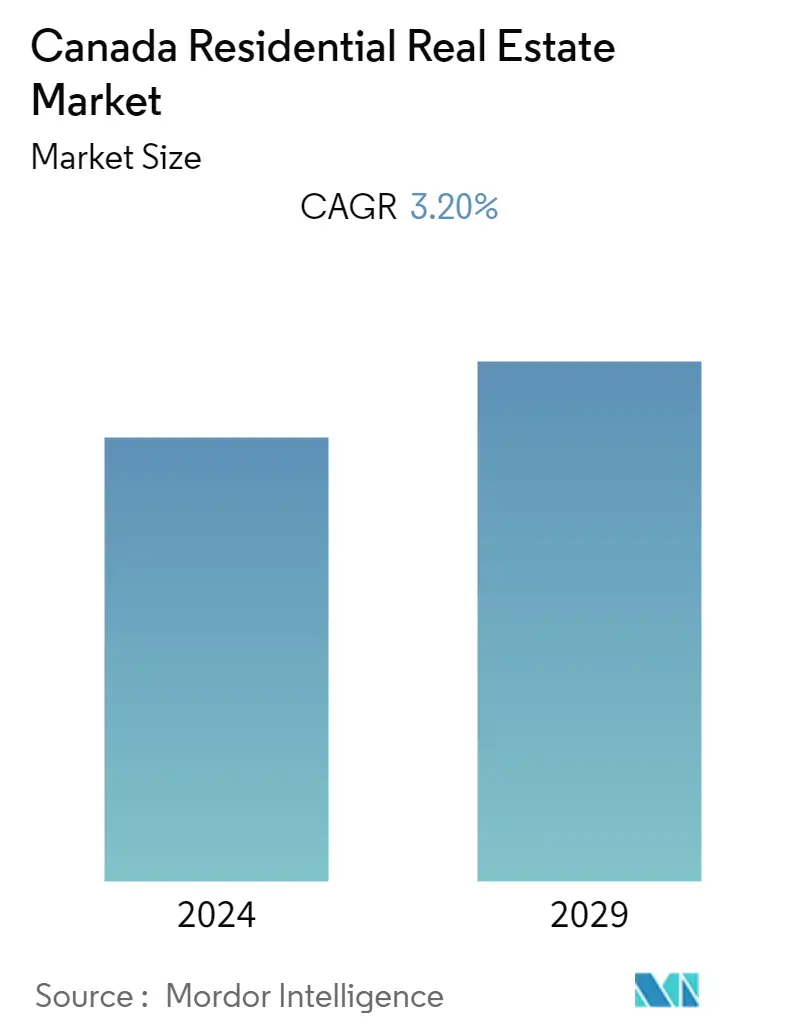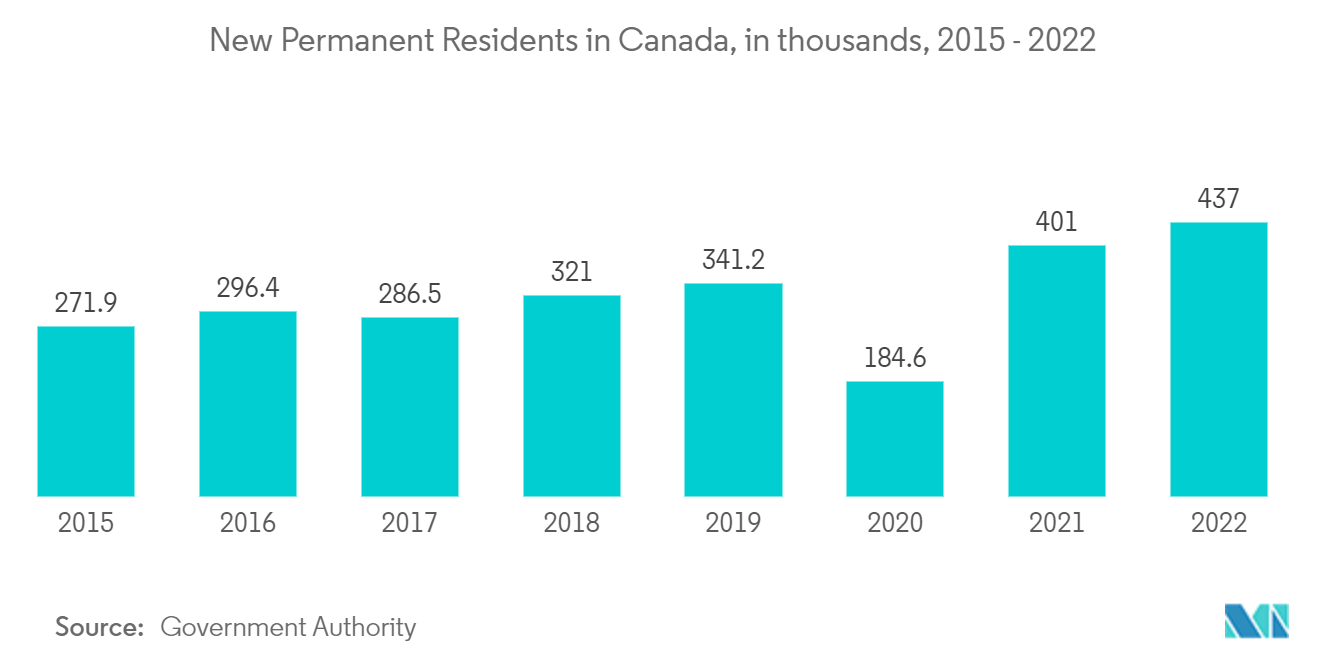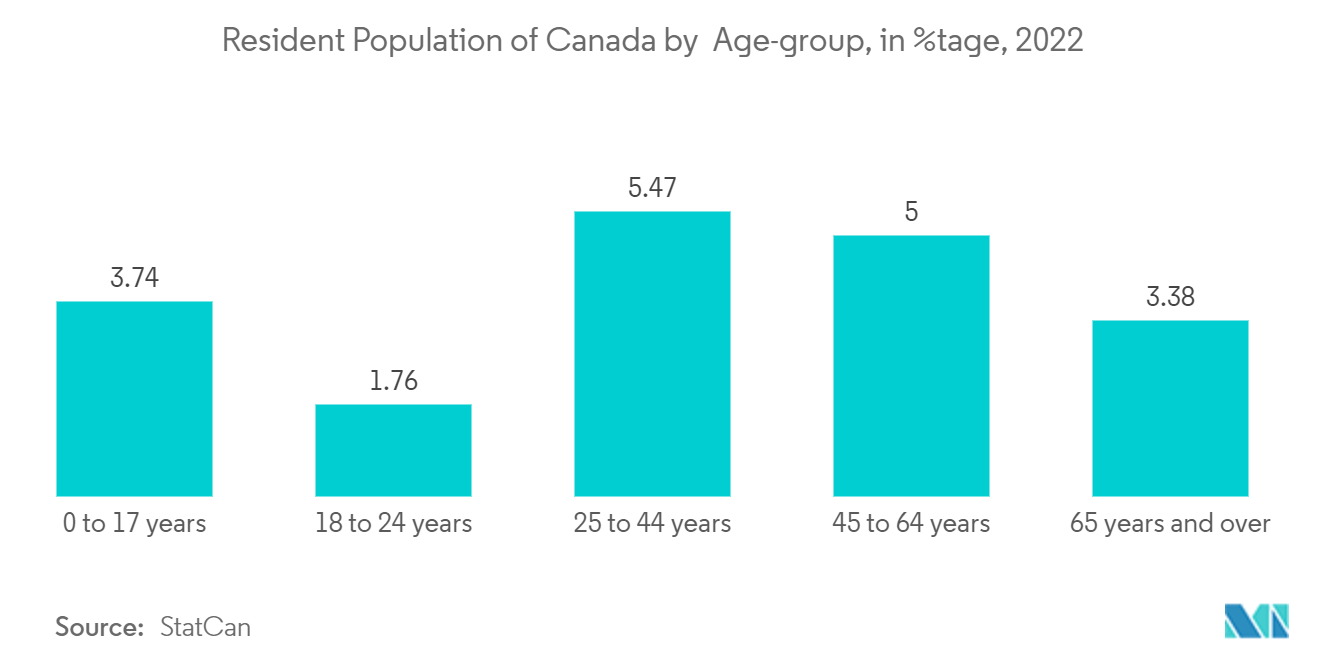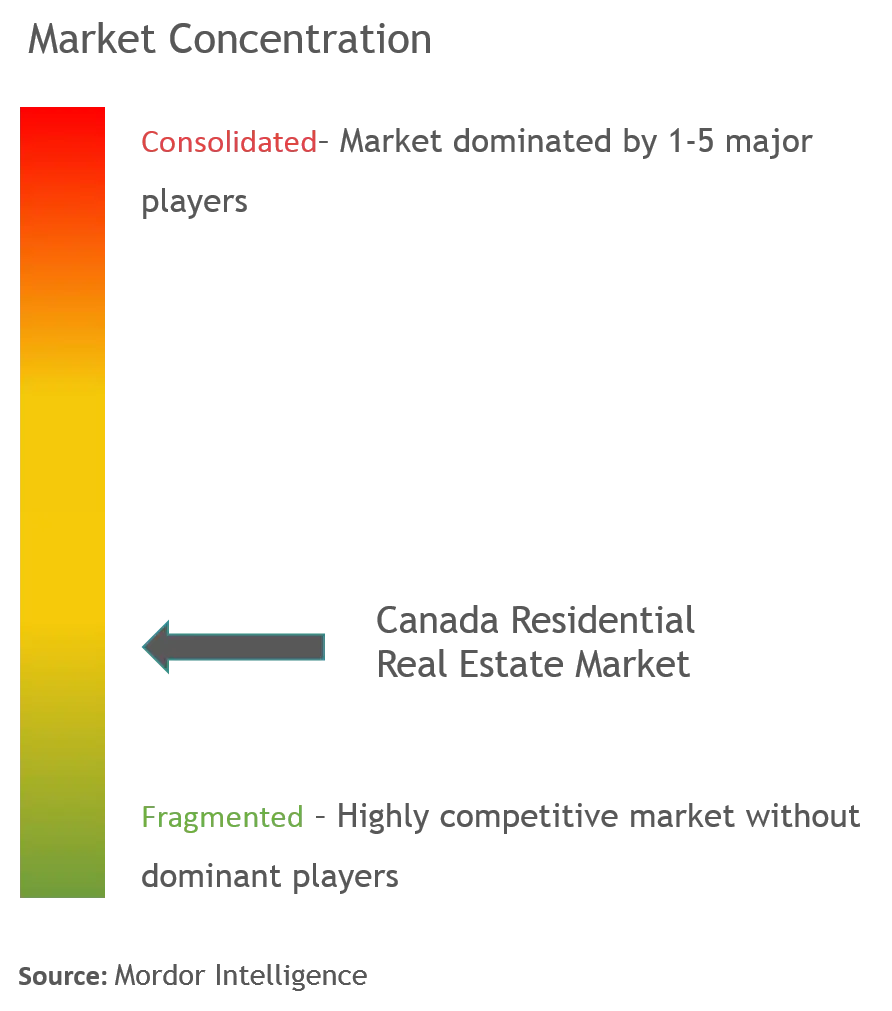Canada Residential Real Estate Market Size

| Study Period | 2020 - 2029 |
| Base Year For Estimation | 2023 |
| Forecast Data Period | 2024 - 2029 |
| Historical Data Period | 2020 - 2022 |
| CAGR | 3.20 % |
| Market Concentration | Low |
Major Players.webp)
*Disclaimer: Major Players sorted in no particular order |
Canada Residential Real Estate Market Analysis
The Canada Residential Real Estate Market size is expected to grow from USD 59.30 billion in 2023 to USD 69.41 billion by 2028, at a CAGR of 3.20% during the forecast period (2023-2028).
- As Canadian home prices continue to grow across the country, the national average home price broke an all-time high in January 2022. The average home price in Canada's housing market in January 2022 was CAD 748,439 (USD 587,487), up by 20% from 2021. That is the biggest year-over-year price gain in the history of the Canadian housing market. Price patterns for four different types of properties are investigated: new houses, new condominiums, resale houses, and resale condominiums. Before 2020, condominium units grew in value faster than single-family, semi-detached, and row residences. Many changes have occurred in the real estate sector since the outbreak, ranging from virtual tours to a preference for larger homes in the suburbs.
- New Brunswick led the country in terms of the highest Y-o-Y price growth among the provinces, with home prices in New Brunswick up 32% Y-o-Y to CAD 275,000 (USD 215,861) for January 2022. The other Atlantic Provinces trailed behind, with Nova Scotia seeing prices increase by 23% Y-o-Y to CAD 392,828 (USD 308,350), Prince Edward Island with an 18% annual gain to CAD 351,890 (USD 276,216), and Newfoundland & Labrador with a 12% annual gain to CAD 324,800 (USD 254,951). Nationally, sales during January 2022 were down 11% Y-o-Y, while new home listings were down 11% month-over-month.
- As a result, inventories of properties for sale have dropped to historic lows, leaving purchasers with few options. The Bank of Canada kept its overnight rate at 0.25%, where it has been since the beginning of the pandemic, in its January 2022 monetary policy review and said that it expects to keep it there through the middle quarters of 2022.
- Due to COVID-19, builders, and buyers have mostly shifted to virtual tours and digital contract signings. The demand for larger houses has grown as working from home becomes more prevalent. According to the Bank of Canada (BoC), the housing affordability index declined by 15.3% in 2, reflecting less restrictive conditions for homeownership. Since then, it has gradually risen to exceed its pre-pandemic level in Q2 2021. The consumer house-buying power increased at the outset of the pandemic because of lower mortgage rates and higher Household Disposable Income (HDI).
\n
Canada Residential Real Estate Market Trends
Immigration Policies are Driving the Market
Immigration has been a major source of economic growth for Canada's successive governments. With the pandemic forcing aged Canadians to retire early, luring immigrants has become increasingly crucial. In addition, the country focuses on high-skilled immigrants, who are more likely to bring money and earn enough to compete for coveted housing. Low mortgage rates and a scarcity of housing have pushed up housing expenses. Another reason was migration, particularly during the pre-pandemic. Immigrants are more likely to buy in large urban areas, such as greater Toronto and Vancouver, where home prices have risen above CAD 1.12 million (USD 88,000), according to Statistics Canada.
To meet the aim of 411,000 immigrants by 2022, the government is anticipated to attract more immigrants from abroad.
As a result, the number of newcomers who set foot on Canadian territory and begin seeking accommodation is expected to increase. This influx of immigrants will have the greatest influence on the rental market, as newcomers are more likely to rent in their first few years in the nation. The great majority of newcomers are settling in Canada's biggest cities, such as Toronto, Vancouver, and Montreal, adding to the housing shortage.

Demographic Factors are Driving the Market
Young Canadians are delaying starting a family as they stay in school longer, start their careers later and face greater challenges in housing affordability than previous generations. Immigration is on the rise, and newcomers are likely to live in multi-generational homes, but this has not yet fully offset the overall decline in household formation. Over the past decade, there has been an increase of nearly 80,000 multi-generational dwellings, but this represents only about 5% of new household formation. During the same period, one-person households represented 44% of all household formation (approximately 700,000 dwellings).
Households are projected to grow 730,000 year-on-year by 2024, or by 240,000 households per year, compared to 2021. Immigration is at the core of this growth. Ottawa's immigration targets are expected to bring in an all-time high of 1.3M new permanent residents by 2024, which would add 555,000 additional households.
As a result of immigration, Canada's population is growing at a rate that is more than double the rate of the OECD over the last decade. This growth combined with declining household sizes will boost demand for homes (both owned and rented) and serve as a strong counterweight to declining sales and prices, eventually putting a lid on the correction.

Canada Residential Real Estate Industry Overview
Canada's Residential Real Estate Market is fragmented in nature with a huge number of global, regional and local players in the market. Some of the major companies in the market include Amacon, Aquilini Development, Concert Properties Ltd, and Century 21 Canada. The rising potential in residential real estate due to increased immigration and the development of infrastructure across various cities is driving the market and creating opportunities for the players to invest in the market.
Canada Residential Real Estate Market Leaders
-
Concert Properties Ltd
-
Aquilini Development
-
Bosa Properties
-
Century 21 Canada
-
Amacon
*Disclaimer: Major Players sorted in no particular order

Canada Residential Real Estate Market News
- October 2022: Dye & Durham Limited ("Dye & Durham") and Lone Wolf Technologies ("Lone Wolf") have announced a brand-new integration that was created specifically for CREA WEBForms powered by Transactions (TransactionDesk Edition) to enable access to and communication with legal services.
- September 2022: ApartmentLove Inc., based in Calgary, has recently acquired OwnerDirect.com and finalized a rental listing license agreement with a significant U.S. aggregator as part of its ongoing acquisition and partnership plans. In 30 countries, ApartmentLove (APLV-CN) offers online house, apartment, and vacation rental marketing services.
Canada Residential Real Estate Market Report - Table of Contents
1. Introduction
- 1.1 Study Assumptions
- 1.2 Scope of the Study
2. Research Methodology
3. Executive Summary
4. Market Insights
- 4.1 Current Economic Scenario and Consumer Sentiment
- 4.2 Residential Real Estate Buying Trends - Socioeconomic and Demographic Insights
- 4.3 Government Initiatives and Regulatory Aspects for the Residential Real Estate Sector
- 4.4 Insights into Size of Real Estate Lending and Loan to Value Trends
- 4.5 Insights into Interest Rate Regime for General Economy and Real Estate Lending
- 4.6 Insights into Rental Yields in the Residential Real Estate Segment
- 4.7 Insights into Capital Market Penetration and REIT Presence in Residential Real Estate
- 4.8 Insights into Affordable Housing Support Provided by Government and Public-private Partnerships
- 4.9 Insights into Real Estate Technology and Startups Active in the Real Estate Segment (Broking, Social Media, Facility Management, and Property Management)
- 4.10 Impact of COVID-19 on the Market
5. Market Dynamics
-
5.1 Drivers
- 5.1.1 Population Growth is the main driving factor
- 5.1.2 Government Initiatives and Regulatory Aspects for the Residential Real Estate Sector
-
5.2 Restraints
- 5.2.1 Housing Supply Shortage
- 5.2.2 Interest rates and Financing
-
5.3 Opportunities
- 5.3.1 Affordable Housing Intiatives
-
5.4 Industry Attractiveness - Porter's Five Forces Analysis
- 5.4.1 Bargaining Power of Suppliers
- 5.4.2 Bargaining Power of Consumers / Buyers
- 5.4.3 Threat of New Entrants
- 5.4.4 Threat of Substitute Products
- 5.4.5 Intensity of Competitive Rivalry
6. Market Segmentation
-
6.1 Type
- 6.1.1 Apartments and Condominiums
- 6.1.2 Villas and Landed Houses
-
6.2 City
- 6.2.1 Toronto
- 6.2.2 Montreal
- 6.2.3 Vancouver
- 6.2.4 Ottawa
- 6.2.5 Cagalry
- 6.2.6 Hamilton
- 6.2.7 Other Cities
7. Competitve Landscape
- 7.1 Overview (Market Concentration and Major Players)
-
7.2 Company Profiles
- 7.2.1 Amacon
- 7.2.2 Concert Properties Ltd
- 7.2.3 Shato Holdings Ltd
- 7.2.4 Aquilini Development
- 7.2.5 Bosa Properties
- 7.2.6 B.C. Investment Management Corp.
- 7.2.7 Brookfield Asset Management
- 7.2.8 Polygon Realty Limited
- 7.2.9 Slavens & Associates
- 7.2.10 Living Realty
- 7.2.11 CAPREIT
- 7.2.12 Century 21 Canada*
- *List Not Exhaustive
8. FUTURE OF THE MARKET
9. APPENDIX
** Subject To AvailablityCanada Residential Real Estate Industry Segmentation
Real estate (land and any buildings on it) used for residential purposes is commonly referred to as residential real estate; single-family dwellings are the most prevalent type of residential real estate.
A complete background analysis of the Canada Residential Real Estate Market, including the assessment of the economy and contribution of sectors in the economy, market overview, market size estimation for key segments, and emerging trends in the market segments, market dynamics, and geographical trends, and COVID-19 impact is included in the report. The Canada Residential Real Estate Market is segmented by Type (Apartments and Condominiums and Villas and Landed Houses) and City (Toronto, Montreal, Vancouver, Ottawa, Calgary, Hamilton, and Other Cities). The report offers market size and forecasts for the Canada Residential Real Estate market in value (USD billion) for all the above segments.
| Type | Apartments and Condominiums |
| Villas and Landed Houses | |
| City | Toronto |
| Montreal | |
| Vancouver | |
| Ottawa | |
| Cagalry | |
| Hamilton | |
| Other Cities |
Canada Residential Real Estate Market Research FAQs
What is the current Canada Residential Real Estate Market size?
The Canada Residential Real Estate Market is projected to register a CAGR of 3.20% during the forecast period (2024-2029)
Who are the key players in Canada Residential Real Estate Market?
Concert Properties Ltd, Aquilini Development, Bosa Properties, Century 21 Canada and Amacon are the major companies operating in the Canada Residential Real Estate Market.
What years does this Canada Residential Real Estate Market cover?
The report covers the Canada Residential Real Estate Market historical market size for years: 2020, 2021, 2022 and 2023. The report also forecasts the Canada Residential Real Estate Market size for years: 2024, 2025, 2026, 2027, 2028 and 2029.
What are the future trends in the Canadian Residential Real Estate Market?
The future trends in the Canadian Residential Real Estate Market are a) Sustainable and energy-efficient housing: Growing focus due to environmental awareness and government regulations b) Smart home technology: Increased integration of home automation and energy management systems c) Online real estate platforms: Continued dominance for property search, virtual tours, and transactions
Canada Residential Real Estate Industry Report
The 3PL Mexico Market Report provides a comprehensive industry analysis, focusing on various segments such as domestic transportation management, international transportation management, and value-added warehousing and distribution. The report highlights the market size and market share in value terms in USD, offering insights into the industry's growth rate and market growth over time.
Key industry trends are discussed, providing an industry overview that includes valuable industry statistics. The report also delves into the market segmentation by end users, including automotive, consumer and retail, energy, healthcare, industrial and aerospace, technology, and other sectors.
This industry research is crucial for understanding the market outlook and market predictions, as it includes a detailed market forecast outlook. The report covers historical data and projections up to the future, making it a valuable resource for market leaders and research companies looking to understand the market value and market data.
The industry reports are designed to provide a thorough market review, offering insights into the industry size and market value. The report example and report pdf are available for a deeper dive into the specifics, making it an essential tool for those interested in the market overview and industry outlook.
Overall, the 3PL Mexico Market Report is an indispensable resource for anyone seeking detailed and reliable market information, including industry trends and market forecast. It serves as a comprehensive guide for understanding the market dynamics, industry sales, and market segmentation, providing a clear picture of the industry's future trajectory.



